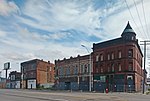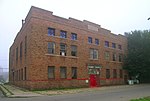Southwest Detroit Hospital
1974 establishments in Michigan1991 disestablishments in Michigan1997 establishments in Michigan2006 disestablishments in MichiganAbandoned hospitals in the United States ... and 6 more
Defunct hospitals in MichiganHospital buildings completed in 1974Hospitals disestablished in 1991Hospitals disestablished in 2006Hospitals established in 1997Unused buildings in Detroit

Southwest Detroit Hospital is an abandoned hospital located in the Mexicantown neighborhood of Detroit, Michigan. It opened in 1973 as the first Detroit hospital to hire and accredit African American doctors and nurses, which was uncommon in the United States at that time. The original hospital was only in existence for 17 years; in 1991, it declared bankruptcy and closed down.In 1997, the hospital re-opened as United Community Hospital; however, due to financial struggles, the hospital closed again in January 2006. Since then, the building has been abandoned, with various redevelopment plans falling through over the years.
Excerpt from the Wikipedia article Southwest Detroit Hospital (License: CC BY-SA 3.0, Authors, Images).Southwest Detroit Hospital
20th Street, Detroit
Geographical coordinates (GPS) Address External links Nearby Places Show on map
Geographical coordinates (GPS)
| Latitude | Longitude |
|---|---|
| N 42.33 ° | E -83.083888888889 ° |
Address
Southwest Detroit Hospital
20th Street 2401
48216 Detroit
Michigan, United States
Open on Google Maps









